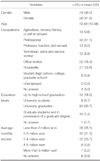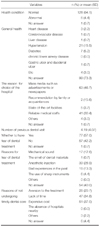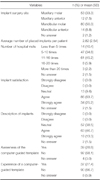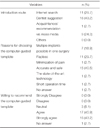1. Hong SJ, Paik JW, Kim CS, Choi SH, Lee KW, Chai JK, Kim CK, Cho KS. The Study of Implant Patient's Type and Implant Distribution. J Korean Acad Periodontol. 2002; 32:539–554.
2. Baek JW. Dental Implant. Korean Soc Eng Educ. 2002; 1:87–90.
3. Brånemark PI, Hansson BO, Adell R, Breine U, Lindström J, Hallén O, Ohman A. Osseointegrated implants in the treatment of the edentulous jaw. Experience from a 10-year period. Scand J Plast Reconstr Surg Suppl. 1977; 16:1–132.
4. Rahman AU, Rehman TU, Qureshi I, Hashim M, Warris N, Mateen S. Pre surgical perception of pain, post surgical pain and its management for patients undergoing dental implant therapy. J Pak Dent Assoc. 2012; 21:5–11.
5. Jaffin RA, Kumar A, Berman CL. Immediate loading of implants in partially and fully edentulous jaws: a series of 27 case reports. J Periodontol. 2000; 71:833–838.
6. Canullo L, Fedele GR, Iannello G, Jepsen S. Platform switching and marginal bone-level alterations: the results of a randomized-controlled trial. Clin Oral Implants Res. 2010; 21:115–121.
7. Cannizzaro G, Leone M, Consolo U, Ferri V, Esposito M. Immediate functional loading of implants placed with flapless surgery versus conventional implants in partially edentulous patients: a 3-year randomized controlled clinical trial. Int J Oral Maxillofac Implants. 2008; 23:867–875.
8. Van der Zee E, Oosterveld P, Van Waas MA. Effect of GBR and fixture installation on gingiva and bone levels at adjacent teeth. Clin Oral Implants Res. 2004; 15:62–65.
9. Brodala N. Flapless surgery and its effect on dental implant outcomes. Int J Oral Maxillofac Implants. 2009; 24:118–125.
10. Jeong SM, Choi BH, Kim J, Xuan F, Lee DH, Mo DY, Lee CU. A 1-year prospective clinical study of soft tissue conditions and marginal bone changes around dental implants after flapless implant surgery. Oral Surg Oral Med Oral Pathol Oral Radiol Endod. 2011; 111:41–46.
11. Becker W, Wikesjö UM, Sennerby L, Qahash M, Hujoel P, Goldstein M, Turkyilmaz I. Histologic evaluation of implants following flapless and flapped surgery: a study in canines. J Periodontol. 2006; 77:1717–1722.
12. Azari A, Nikzad S. Flapless implant surgery: review of the literature and report of 2 cases with computer-guided surgical approach. J Oral Maxillofac Surg. 2008; 66:1015–1021.
13. Sudbrink SD. Computer-guided implant placement with immediate provisionalization: a case report. J Oral Maxillofac Surg. 2005; 63:771–774.
14. Lee JH, Park JM, Kim SM, Kim MJ, Lee JH, Kim MJ. An assessment of template-guided implant surgery in terms of accuracy and related factors. J Adv Prosthodont. 2013; 5:440–447.
15. Park JM, Yi TK, Jung JK, Kim Y, Park EJ, Han CH, Koak JY, Kim SK, Heo SJ. Accuracy of 5-axis precision milling for guided surgical template. J Korean Acad Prosthodont. 2010; 48:294–300.
16. Valente F, Schiroli G, Sbrenna A. Accuracy of computer-aided oral implant surgery: a clinical and radiographic study. Int J Oral Maxillofac Implants. 2009; 24:234–242.
17. Fortin T, Bosson JL, Coudert JL, Isidori M. Reliability of preoperative planning of an image-guided system for oral implant placement based on 3-dimensional images: an in vivo study. Int J Oral Maxillofac Implants. 2003; 18:886–893.
18. Misir AF, Sumer M, Yenisey M, Ergioglu E. Effect of surgical drill guide on heat generated from implant drilling. J Oral Maxillofac Surg. 2009; 67:2663–2668.
19. Marković A, Mišić T, Miličić B, Calvo-Guirado JL, Aleksić Z, ÐDinić A. Heat generation during implant placement in low-density bone: effect of surgical technique, insertion torque and implant macro design. Clin Oral Implants Res. 2013; 24:798–805.
20. Jeong SM, Yoo JH, Fang Y, Choi BH, Son JS, Oh JH. The effect of guided flapless implant procedure on heat generation from implant drilling. J Craniomaxillofac Surg. 2013; S1010-5182(13).
21. Kim KW, Lee KS, Kang PS, Kim WS, Lee HK. Comparison of chewing ability and quality of life before and after the dental implantation. J Korean Acad Prosthodont. 2009; 47:215–221.
22. Attard NJ, Zarb GA. Implant prosthodontic management of partially edentulous patients missing posterior teeth: the Toronto experience. J Prosthet Dent. 2003; 89:352–359.
23. Zarb GA, Albrektsson T. Consensus report: towards optimized treatment outcomes for dental implants. J Prosthet Dent. 1998; 80:641.
24. McGrath C, Lam O, Lang N. An evidence-based review of patient-reported outcome measures in dental implant research among dentate subjects. J Clin Periodontol. 2012; 39:193–201.
25. Erkapers M, Ekstrand K, Baer RA, Toljanic JA, Thor A. Patient satisfaction following dental implant treatment with immediate loading in the edentulous atrophic maxilla. Int J Oral Maxillofac Implants. 2011; 26:356–364.
26. González-Lemonnier S, Bovaira-Forner M, Peñarrocha-Diago M, Peñarrocha-Oltra D. Relationship between preoperative anxiety and postoperative satisfaction in dental implant surgery with intravenous conscious sedation. Med Oral Patol Oral Cir Bucal. 2010; 15:e379–e382.
27. Han JH, Kim KE. Comparison of Expectation and Satisfaction of Implant Patients in Pre-post Implant Therapy. J Dent Hyg Sci. 2011; 11:121–127.
28. Heo YY, Heo SJ, Chang MW, Park JM. The patients' satisfaction following implant treatment. J Korean Acad Prosthodont. 2008; 46:569–576.
29. Choi BH, Jeong SM, Kim J, Engelke W. Flapless implantology. 1st ed. London: Quintessence Publishing Co;2010. p. 66–71.
30. Van Assche N, van Steenberghe D, Guerrero ME, Hirsch E, Schutyser F, Quirynen M, Jacobs R. Accuracy of implant placement based on pre-surgical planning of three-dimensional cone-beam images: a pilot study. J Clin Periodontol. 2007; 34:816–821.
31. Horwitz J, Zuabi O, Machtei EE. Accuracy of a computerized tomography-guided template-assisted implant placement system: an in vitro study. Clin Oral Implants Res. 2009; 20:1156–1162.
32. Huskisson EC. Measurement of pain. Lancet. 1974; 2:1127–1131.
33. Meskin LH, Brown LJ. Prevalence and patterns of tooth loss in U.S. employed adult and senior populations, 1985-86. J Dent Educ. 1988; 52:686–691.
34. Kim GU, Cho SM. A Study on the Factors Giving Effects to Patient's Satisfaction in the Selection of Implant Operation. J Korea Acad-Ind Coop Soc. 2010; 11:4354–4359.
35. Shin HC, Choi HS. The Impact of Physician Behaviors on Patient Satisfaction. J Korean Acad Fam Med. 1994; 15:1157–1170.
36. Kvale G, Berg E, Nilsen CM, Raadal M, Nielsen GH, Johnsen TB, Wormnes B. Validation of the Dental Fear Scale and the Dental Belief Survey in a Norwegian sample. Community Dent Oral Epidemiol. 1997; 25:160–164.
37. Han SH. Anxiety and fear of dental patient. J Korean Dent Assoc. 1993; 31:1–8.
38. Kim KW, Nam CH. A Study of Students' Knowledge Level of Dental Health Care. J Korean Soc Sch Health. 2000; 13:295–317.
39. Ganzberg S, Pape RA, Beck FM. Remifentanil for use during conscious sedation in outpatient oral surgery. J Oral Maxillofac Surg. 2002; 60:244–250.
40. Garip H, Gürkan Y, Toker K, Göker K. A comparison of midazolam and midazolam with remifentanil for patient-controlled sedation during operations on third molars. Br J Oral Maxillofac Surg. 2007; 45:212–216.














 PDF
PDF ePub
ePub Citation
Citation Print
Print




 XML Download
XML Download